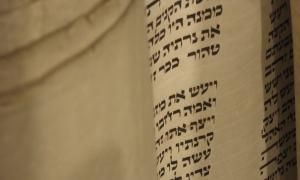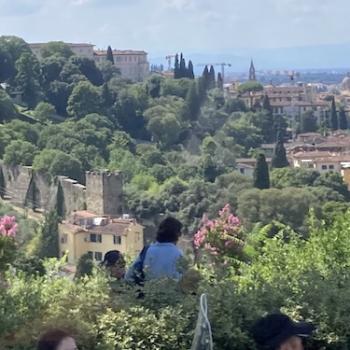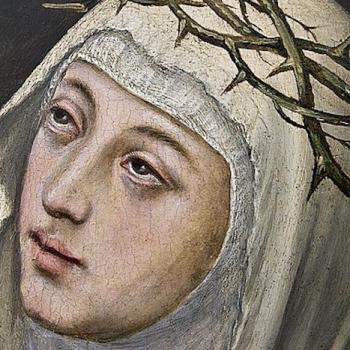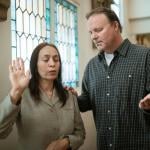
I wrote earlier about the Transfiguration of Christ as an unveiling of what God experiences when we pray. Now I’d like to take another look at that same story as an insight into what St. Luke was trying to say about the Christian way of reading Israel’s scriptures. Specifically, what is going on when Moses and Elijah appear on the mountain with Jesus?
Isn’t it odd, though, that Christian’s even get to interpret Israel’s scriptures?
Families of Interpretation
The key distinction between the synagogue and the church has, from the very beginning, been a matter of exegesis. Specifically: how to interpret the set of writings that Jews call the Bible and that Christians call the Old Testament. The two communities form around two interpretations. Or, better said, two families of interpretation. Differences of liturgy, haberdashery, and calendar matter too, but they are manifestations of the base divergence. We read the Bible differently.
That is only a problem if one thinks of interpretive disagreements as a deal-breaker in a relationship. Jews and Christians have at various times in history found the difference to be an invitation to dialogue rather than a motivation to violence. This was true for a time in ancient Alexandria, and again of the early universities of Europe, and again in the Muslim city of Cordoba, Spain. It was also true in the graduate department at the University of Virginia, where I cut my theological teeth. I’ll return to that heritage, briefly, below. But let’s take another look, first, at the Transfiguration story.
Moses, Elijah, and Jesus
Luke tells us that “while he was praying, the appearance of his face changed, and his clothes became dazzling white.” The reference to his face is surely meant to make us think of Moses, as I said earlier. Moses also went up a mountain to pray. And when he came down, the glare off his face was so bright that he wore a veil to protect those whose eyes weren’t adjusted to the Sinai light.
And sure enough, Moses appears there on the mountain with Jesus. And not just Moses, but Elijah as well. Luke even tells us what they talk about: “his departure, which he was about to accomplish in Jerusalem.” The implication here seems clear enough. Torah and the Prophets “talk about” the death, resurrection, and ascension of the Messiah. It’s the same thing Jesus explains later on the walk to Emmaus (24:7). If you read carefully, Jesus tells those two, you will hear Moses and all the Elijahs of Israel telling you that about what has come to pass in these last days.
The Words and the Silences
Maximus the Confessor, in his reading of the story, stays with Moses and Elijah just a bit longer. Moses, the one who wore a veil so he could walk back down the mountain and bring God’s presence to the people. Elijah, who discards even his cloak as he ascends in a chariot into God’s presence. Moses, the father of kataphatic theology, or theology spoken in human affirmations. Elijah, the father of apophatic theology, the kind of speaking that ends in naked, mystified silence.
That both are there, talking with Jesus while he prays, centers our attention on this moment. All the Law and the Prophets culminate here, in the “departure” of Jesus. Affirmatively, or kataphatically: here is the sum total of all that humans can say about the God of Israel. The whole point of Torah: God walks among us as a humanly spoken Word.
Negatively, or apophatically: here is the mysterious silence that lies beyond all we can affirm. The God of all that walking and speaking is inviting us into an abundant and limitless life. We will leave all the words behind as we rush toward God’s presence in a chariot of fire.
That is what they talk about: his departure. Jesus is the Moses who descends, and he’s the Elijah who ascends. He comes among us for companionship, but his leaving is our invitation into divine abundance. Christ will depart, and this departure will be God’s great accomplishment.
Three Houses?
This helps make sense, actually, of what happens next. Peter offers to build three shelters, then a cloud overshadows them, just as it did on Sinai. They hear a voice identifying Jesus as “my Son.” And then the cloud lifts, and they see Jesus alone.
Peter, whatever else he was thinking with his strange suggestion, believes that these three interlocutors need three separate homes. Like those Emmaus disciples, he hasn’t yet recognized the one before him. He is in a fog. “This is my Son,” says the God of Israel. This is who I have been among you through everything that happened on Sinai and on the Jordan’s banks outside Jericho.
When Jesus is alone at the end, it’s not because Moses and Elijah are no longer there, but because the vision has come to an end. What Peter, James, and John had seen was what had been there from the beginning. Jesus is the Son, in constant conversation with the veiled-face Lawgiver and the cloak-shedding Prophet. He is a walking hermeneutic of Israel’s scriptures. Moses and Elijah are there still, wherever Jesus is. He is the fulfillment of all their words and silences. They all only need one shelter.
Arguing over Israel’s Scriptures
That, at least, is what I take to be the Christian reading. Most synagogues would, I imagine, find fault with my interpretation.
Peter Ochs, my “conservadox” Jewish professor at UVa, once said to me, “you Christians think we’ll all argue over texts on earth, and when we get to heaven we’ll finally get the answers. Jews believe that when we arrive, there’ll still be five rabbis arguing over Torah.”
I like the idea of heaven as a place where we all get to keep arguing over interpretation. If I make it in, I hope Professor Ochs invites me to his Bible Study.










